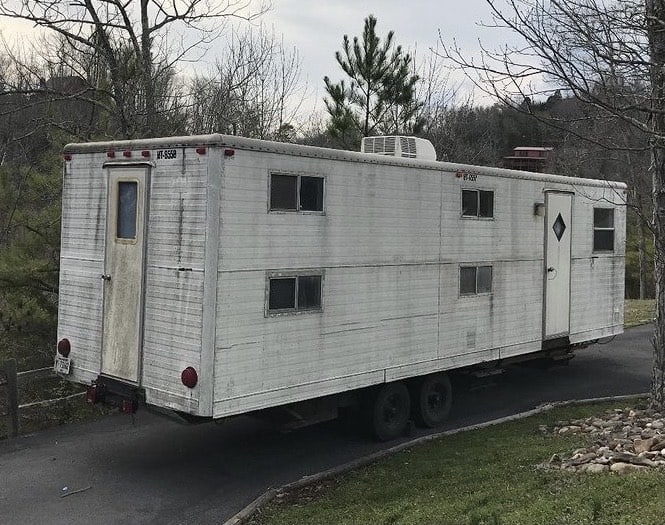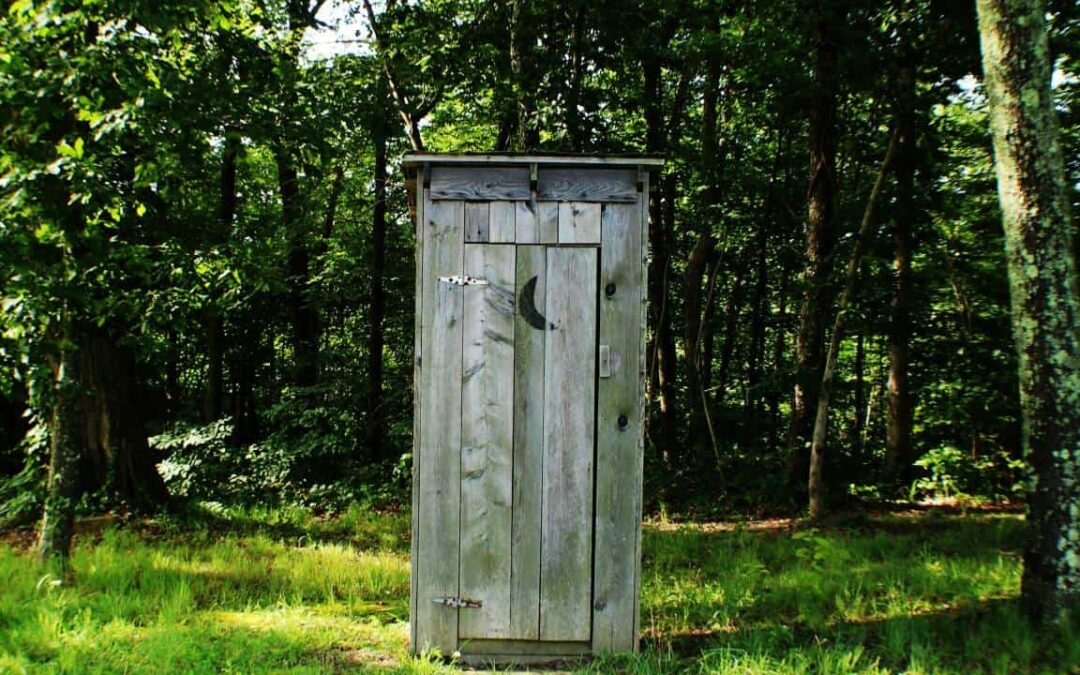“Wham! Wham! Wham!”, the sound that woke me up, again, at 2am.
Who do you complain to when it’s your Landlord, who shares a wall with you, that’s making the noise?
Your roommate too, who conveniently never got around to signing her own lease, also just gave you a two-week notice that she’s moving out.
“That’s it!” I told myself. “I’m done with Craigslist roommates and I’m oversharing walls with people.”
The only affordable solution, that wouldn’t leave me spending my entire paycheck on my own place, seemed to be a 5th Wheel trailer or a tiny house.
“You don’t want to live in a 5th wheel – they aren’t insulated well and I’ve heard the side outs leak,”
Mom told me, for probably the fifth time. “Yeah, but I have $10,000 in my account. How will I ever afford to build a tiny house?”, I asked. “A used 5th wheel will be so much cheaper than building my own place.”
Finding a Tiny Home to Fit my Needs
A house on wheels seemed to fit my lifestyle too… I have moved over 14 times and lived in over six different states.
I find myself moving every few years for a new job or my next venture.
After graduating with my BFA, I moved to Texas and to Virginia to be an International Flight Attendant.
Then I moved to Alabama to pursue my MBA. Now I live in Las Vegas. My life has been pretty unpredictable and a house on wheels would allow me to follow my heart without worrying about housing and strange roommates.
A few months after I had officially decided to live in something on wheels, I found myself at a public Railroad Surplus Auction that my Dad had found out about (a quick Google search for “Railroad Surplus Auction” will locate events around the country).
There were old Railroad Camp Cars up for auction; they had once housed six tired Railroad workers after a hard day of working on the rails.
Inside were six bunk beds, a kitchen, and a shower. Some of them had also been gutted and turned into portable meeting rooms.
The railroad had discovered that in most cases, it is actually cheaper to put workers up in hotels just for the time they worked and pay per diem vs. pay for a cook to live on the camp car and pay for the workers’ meals every day they were away from home.
Therefore, they didn’t have the same need for the Cars anymore.
“If I can get a Railroad Camp Car for less than $300, I’ll take it as a sign and I’ll buy it.”, I thought to myself.
The first trailer went for over $1,500 and it was in worse shape than the one I had my eye on. I had never bid in an auction in my life. My heart was in my throat when my camp car came up. I made the first bid for $100 and an old guy bid immediately against me. I think he saw the hurt and worry in my eyes and he didn’t bid me past $300. “SOLD!”, to me? Oh my gosh. You mean I own this thing?! Yay! But also, oh my gosh, I have so much work to do now.

My Tiny Home Renovation Journey
I graduated a few weeks later with my MBA, and kissed Birmingham, Alabama goodbye.
I drove up to Dandridge, TN with my co-pilot, Banjo, the ½ weenie dog.
My Mom, Dad, and I started immediately the renovation of the camp car that I had named Journey.
It took three months of hard work to get Journey renovated.
I’m not going to glamorize it – we argued, a lot. We ran to Lowe’s three times a day, almost every day. But Dad had pretty much every tool we needed and Mom and Dad definitely had the know-how. I couldn’t have done it without them. For their problem solving and determination, I will be forever thankful.

My Tiny Home Renovation Costs & Resources
We renovated Journey for less than $9,000 and we estimate we did about $10,000 in labor ourselves.
The only thing we hired out was the electricity, to my Dad’s friend.
I’ve always been a bargain shopper and have loved the thrill of finding something good in a thrift store.
I also love charity, and I was able to infuse my love of both into building Journey. Used and second-hand building supplies kept the cost way down.

My flooring came from the Habitat for Humanity ReStore; proceeds from their sales help to build homes for people who can’t afford them. Items were also donated to me from neighbors who were doing their own renovation – they gave me my countertop and I refinished it, and they also gave me my kitchen faucet.
My bathroom vanity was a vintage writing desk that was bought at an auction that helps support a local dog rescue.
My cabinets were bought off Craigslist for $100; I refinished some and what I didn’t need I re-listed on Craigslist and sold for $100 (= free cabinets).
My washer/dryer and fridge was bought from an extended stay hotel that was updating its appliances.
What I couldn’t buy second hand came from a building liquidation warehouse.
Figuring out the Blueprint of my Tiny Home
To figure out how to layout my tiny home, my mom drew my house to scale on graph paper, and then she drew my furniture to scale and we were able to slide it around.
The trickiest part of designing the floorplan was trying to have both a full-size bed and a living room space.
We solved that problem by building a platform over my bed and putting it on wheels.
My bed pulls out into my kitchen area and my living room is on top of my bed platform. I was able to build my bed rack from a used rug display rack from a Pier 1 that was going out of business.
We mounted wheels on the rack and used the hardware the rug display rack was mounted on (think like a pocket door style-hardware) to mount my bathroom door.
The door now slides into the wall to save space. From the Pier 1 that was closing, I also bought the wood shelving displays with moveable shelf pins to build my closet, so my closet is fully adjustable.
My closet doors are from the landfill. Some other things I considered when building was selecting interior items that didn’t weigh much – like faux brick vs. real brick and my shower is lined with roofing metal instead of tile.

What it’s like Living in Journey
A day after renovating was done, my parents and I drove the 11,000 pound Journey to Vegas and I have been living there 3.5 years and working at UNLV as an Outdoor Adventure Program Coordinator.
It actually was not that hard for me to physically adjust to the smaller living space.
I found it a little harder to sell the antiques I had collected over the years, but the joy of living in my own free-standing house far outweighs the joy I had in using my antiques.
I think what also made the transition to living tiny more seamless was that I made sure I still had room to store the supplies for my hobbies, like outdoor recreation and art. The space under my living room platform that isn’t used by my mattress is all backpacking, rock climbing, and paddling gear storage.
I also put some of those Craigslist cabinets in my living room for painting and jewelry making supplies.
The Lessons I Learned From my Tiny House Journey
The experience I’ve had with the renovation of Journey is really empowering.
I never thought I could make something like this happen.
On the road trip with Journey from Tennessee to Las Vegas, my mom and I were talking about how our story would make a unique children’s book, and with my art skills, I could illustrate it.
I began to scratch some rhymes down on paper as our tires hummed on the interstate. Three hours later, I read my story out loud to Mom, and we made a few edits.
Life for the next 3.5 years was pretty busy making new friends and exploring the alien western landscape. The story I had written about Journey drifted to the back burner until Covid’s quarantine came around.
With the new downtime, I was finally able to illustrate, and self publish the book. It is one of the only books out there for children, regarding tiny home renovation.
And it’s a true story. Every page is my own drawing that I brightly and intensely watercolored. I put a “Seek and Find” activity in the back, so that kids can try to find items hidden throughout the book. I titled it “How Journey Came To Be A Tiny House For Me” and it’s available on Amazon for $14.99.

In Conclusion…
I would encourage you to use quarantine for good! Try to do things you weren’t sure you’d ever have time to do, develop a new hobby or start the build of your own tiny house!




